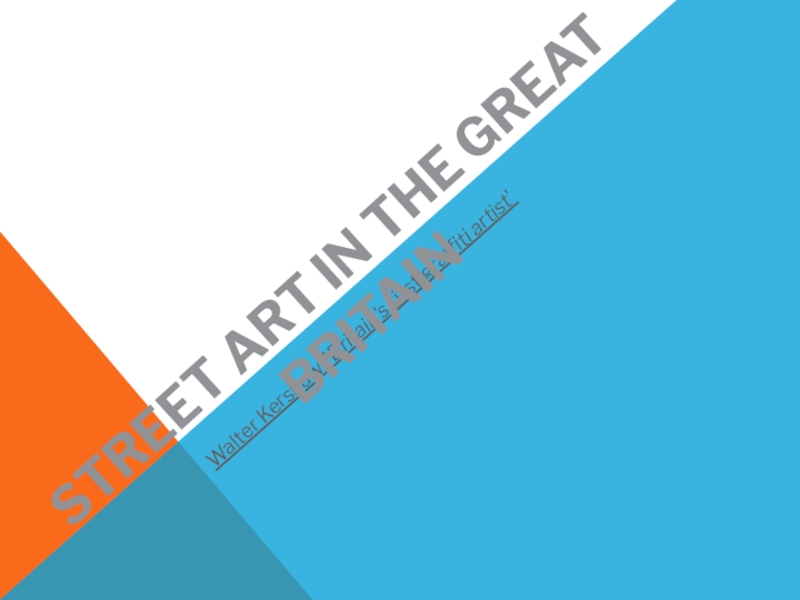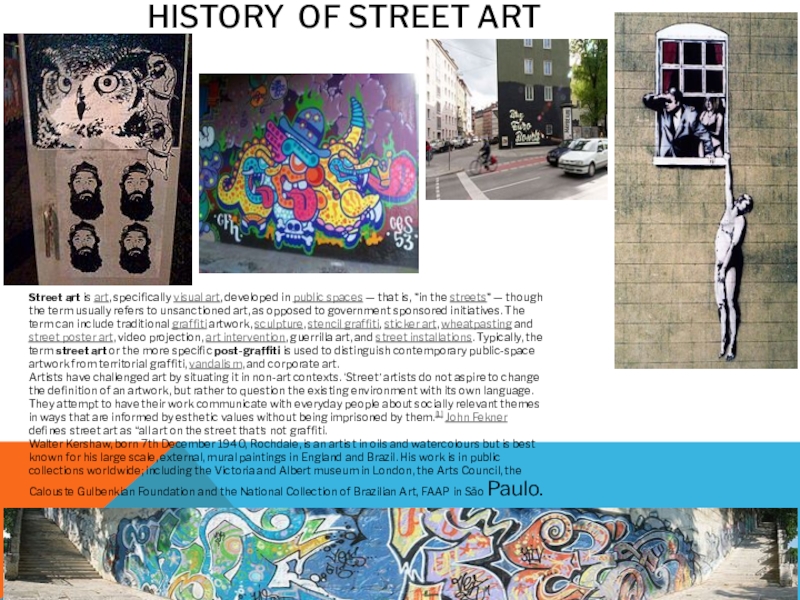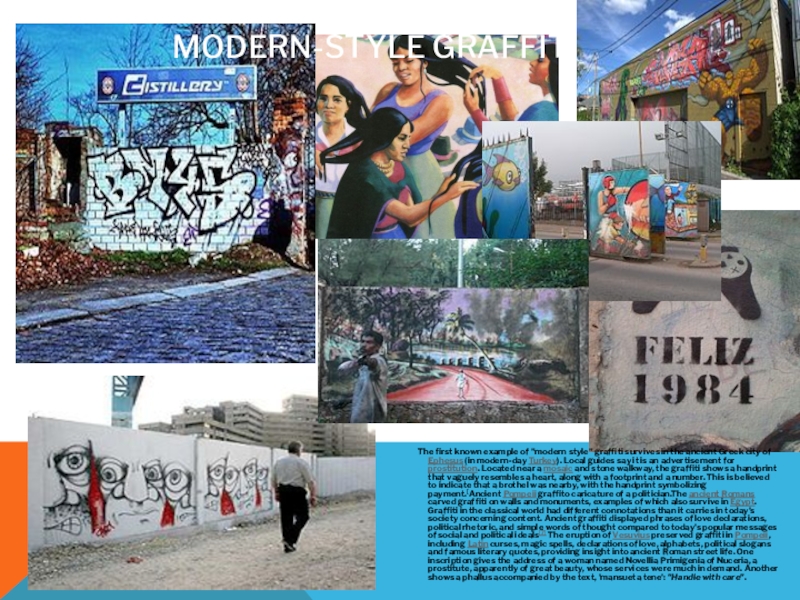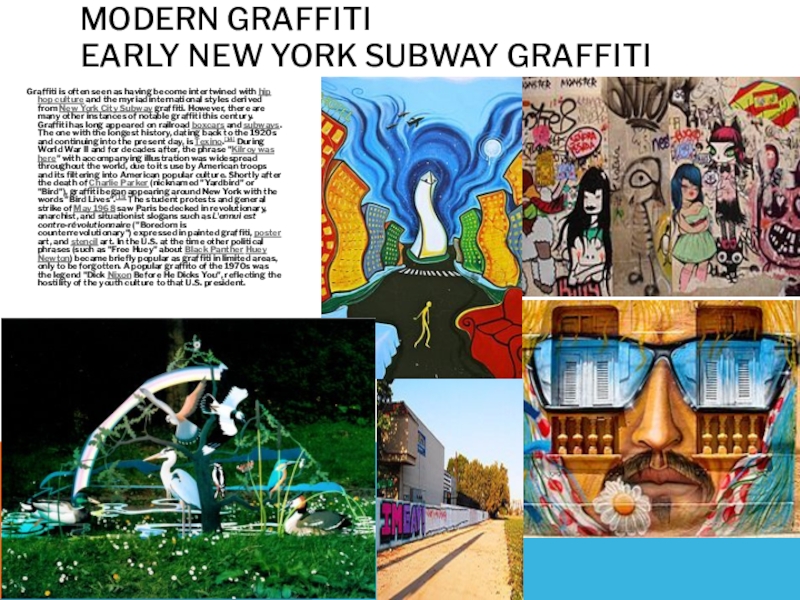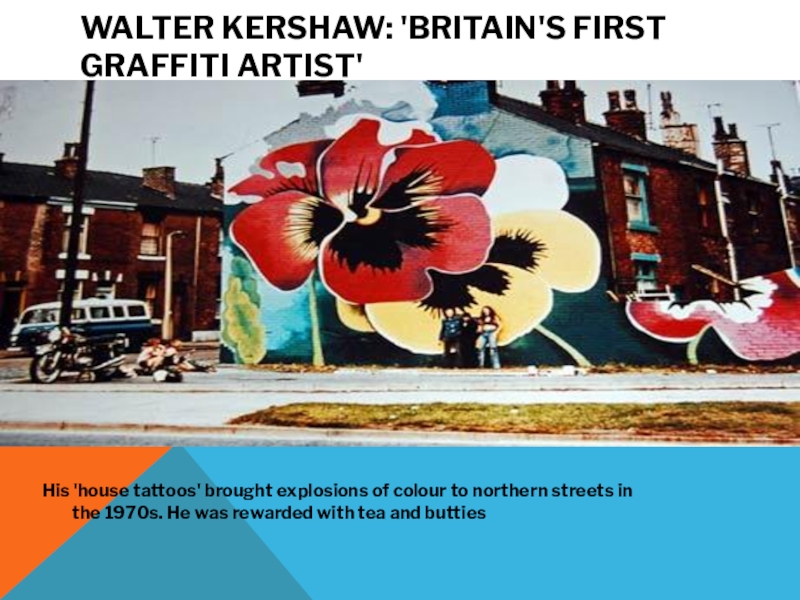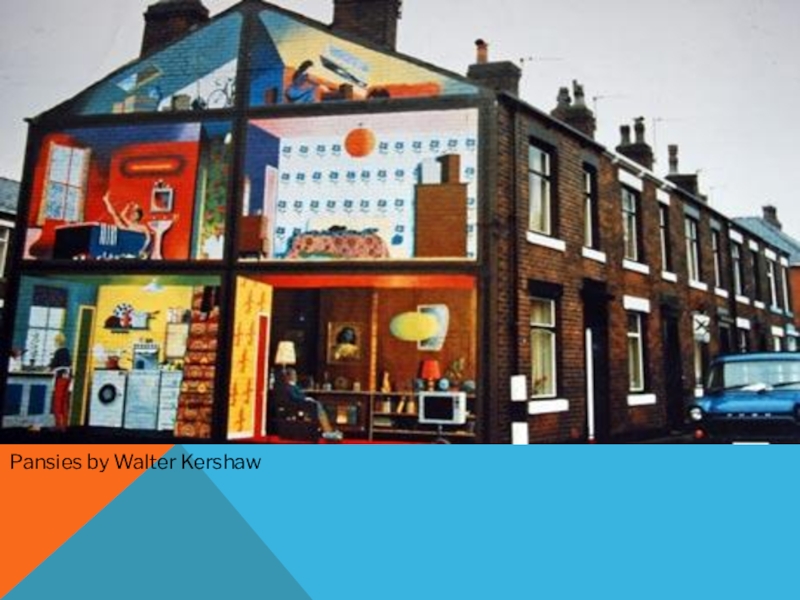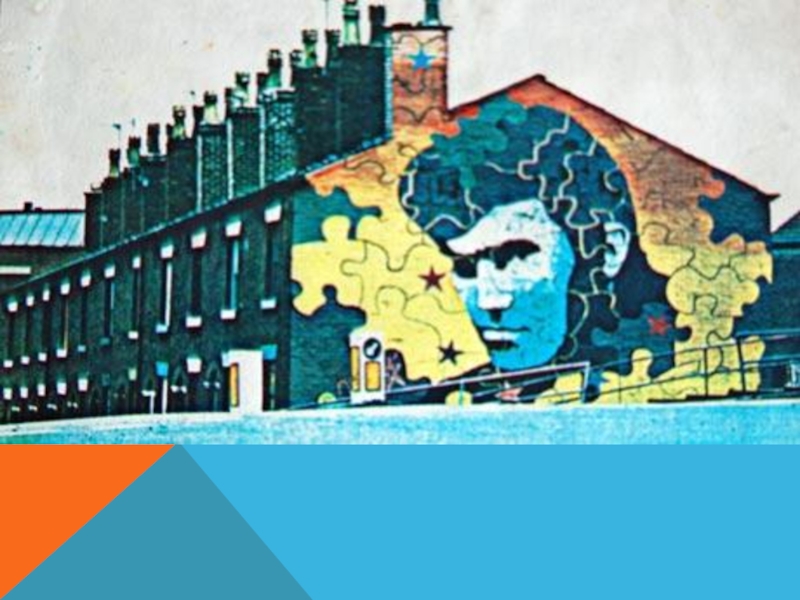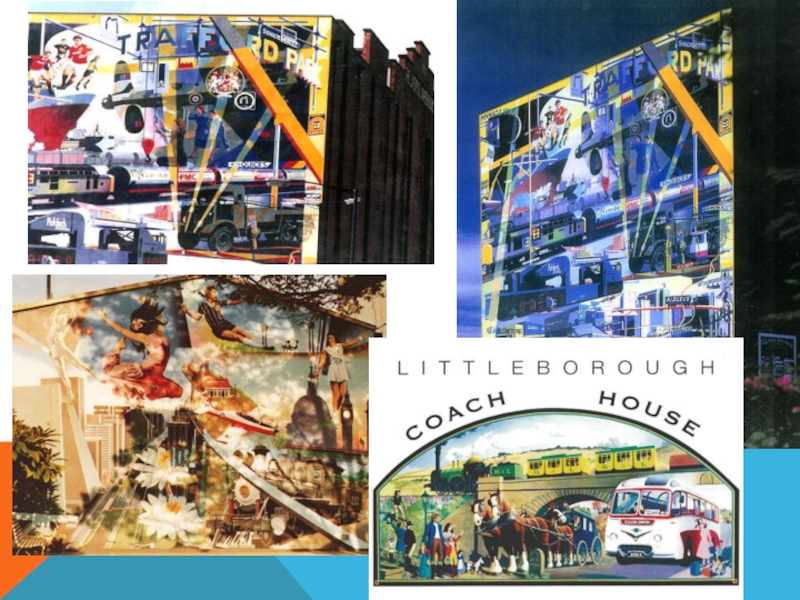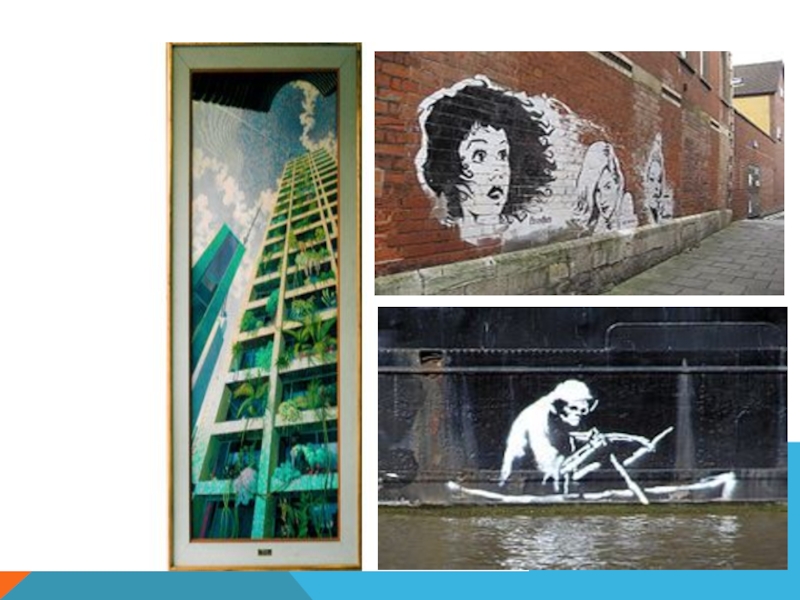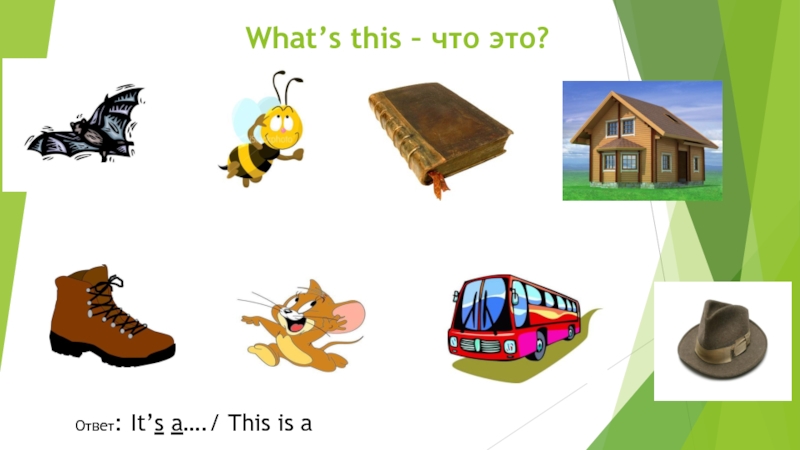- Главная
- Разное
- Образование
- Спорт
- Естествознание
- Природоведение
- Религиоведение
- Французский язык
- Черчение
- Английский язык
- Астрономия
- Алгебра
- Биология
- География
- Геометрия
- Детские презентации
- Информатика
- История
- Литература
- Математика
- Музыка
- МХК
- Немецкий язык
- ОБЖ
- Обществознание
- Окружающий мир
- Педагогика
- Русский язык
- Технология
- Физика
- Философия
- Химия
- Шаблоны, фоны, картинки для презентаций
- Экология
- Экономика
Презентация, доклад на тему Theme : Street art in the Great britain
Содержание
History of street art Street art is art, specifically visual art, developed in public spaces — that is, "in the streets" — though the term usually refers to unsanctioned art, as opposed to government sponsored initiatives. The term
Слайд 2History of street art
Street art is art, specifically visual art, developed
in public spaces — that is, "in the streets" — though the term usually refers to unsanctioned art, as opposed to government sponsored initiatives. The term can include traditional graffiti artwork, sculpture, stencil graffiti, sticker art, wheatpasting and street poster art, video projection, art intervention, guerrilla art, and street installations. Typically, the term street art or the more specific post-graffiti is used to distinguish contemporary public-space artwork from territorial graffiti, vandalism, and corporate art.
Artists have challenged art by situating it in non-art contexts. ‘Street’ artists do not aspire to change the definition of an artwork, but rather to question the existing environment with its own language. They attempt to have their work communicate with everyday people about socially relevant themes in ways that are informed by esthetic values without being imprisoned by them.[1] John Fekner defines street art as “all art on the street that’s not graffiti.
Walter Kershaw, born 7th December 1940, Rochdale, is an artist in oils and watercolours but is best known for his large scale, external, mural paintings in England and Brazil. His work is in public collections worldwide; including the Victoria and Albert museum in London, the Arts Council, the Calouste Gulbenkian Foundation and the National Collection of Brazilian Art, FAAP in São Paulo.
Artists have challenged art by situating it in non-art contexts. ‘Street’ artists do not aspire to change the definition of an artwork, but rather to question the existing environment with its own language. They attempt to have their work communicate with everyday people about socially relevant themes in ways that are informed by esthetic values without being imprisoned by them.[1] John Fekner defines street art as “all art on the street that’s not graffiti.
Walter Kershaw, born 7th December 1940, Rochdale, is an artist in oils and watercolours but is best known for his large scale, external, mural paintings in England and Brazil. His work is in public collections worldwide; including the Victoria and Albert museum in London, the Arts Council, the Calouste Gulbenkian Foundation and the National Collection of Brazilian Art, FAAP in São Paulo.
Слайд 3 Modern-style graffiti
The first known example of "modern style" graffiti survives in the ancient Greek city of Ephesus (in modern-day Turkey). Local guides say it is an advertisement for prostitution. Located near a mosaic and stone walkway, the graffiti shows a handprint that vaguely resembles a heart, along with a footprint and a number. This is believed to indicate that a brothel was nearby, with the handprint symbolizing payment.[Ancient Pompeii graffito caricature of a politician.The ancient Romans carved graffiti on walls and monuments, examples of which also survive in Egypt. Graffiti in the classical world had different connotations than it carries in today's society concerning content. Ancient graffiti displayed phrases of love declarations, political rhetoric, and simple words of thought compared to today's popular messages of social and political ideals[7] The eruption of Vesuvius preserved graffiti in Pompeii, including Latin curses, magic spells, declarations of love, alphabets, political slogans and famous literary quotes, providing insight into ancient Roman street life. One inscription gives the address of a woman named Novellia Primigenia of Nuceria, a prostitute, apparently of great beauty, whose services were much in demand. Another shows a phallus accompanied by the text, 'mansueta tene': "Handle with care".
Слайд 4Modern graffiti
Early New York subway graffiti
Graffiti is often seen as having become intertwined with hip hop culture and the myriad international styles derived from New York City Subway graffiti. However, there are many other instances of notable graffiti this century. Graffiti has long appeared on railroad boxcars and subways. The one with the longest history, dating back to the 1920s and continuing into the present day, is Texino.[14] During World War II and for decades after, the phrase "Kilroy was here" with accompanying illustration was widespread throughout the world, due to its use by American troops and its filtering into American popular culture. Shortly after the death of Charlie Parker (nicknamed "Yardbird" or "Bird"), graffiti began appearing around New York with the words "Bird Lives".[15] The student protests and general strike of May 1968 saw Paris bedecked in revolutionary, anarchist, and situationist slogans such as L'ennui est contre-révolutionnaire ("Boredom is counterrevolutionary") expressed in painted graffiti, poster art, and stencil art. In the U.S. at the time other political phrases (such as "Free Huey" about Black Panther Huey Newton) became briefly popular as graffiti in limited areas, only to be forgotten. A popular graffito of the 1970s was the legend "Dick Nixon Before He Dicks You", reflecting the hostility of the youth culture to that U.S. president.
Слайд 5Walter Kershaw: 'Britain's first graffiti artist'
His 'house tattoos' brought explosions of
colour to northern streets in the 1970s. He was rewarded with tea and butties
